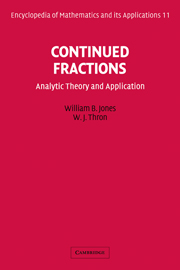Book contents
- Frontmatter
- Contents
- Editor's Statement
- Section Editor's Foreword
- Introduction by Peter Henrici
- Preface
- Symbols
- Continued Fractions
- Chapter 1 Introduction
- Chapter 2 Elementary Properties of Continued Fractions
- Chapter 3 Periodic Continued Fractions
- Chapter 4 Convergence of Continued Fractions
- Chapter 5 Methods for Representing Analytic Functions by Continued Fractions
- Chapter 6 Representations of Analytic Functions by Continued Fractions
- Chapter 7 Types of Corresponding Continued Fractions and Related Algorithms
- Chapter 8 Truncation-Error Analysis
- Chapter 9 Asymptotic Expansions and Moment Problems
- Chapter 10 Numerical Stability in Evaluating Continued Fractions
- Chapter 11 Application of Continued Fractions to Birth-Death Processes
- Chapter 12 Miscellaneous Results
- Appendix A Classification of Special Types of Continued Fractions
- Appendix B Additional Results on Minimal Solutions of Three-Term Recurrence Relations
- Bibliography
- Author Index
- Subject Index
Chapter 7 - Types of Corresponding Continued Fractions and Related Algorithms
Published online by Cambridge University Press: 04 August 2010
- Frontmatter
- Contents
- Editor's Statement
- Section Editor's Foreword
- Introduction by Peter Henrici
- Preface
- Symbols
- Continued Fractions
- Chapter 1 Introduction
- Chapter 2 Elementary Properties of Continued Fractions
- Chapter 3 Periodic Continued Fractions
- Chapter 4 Convergence of Continued Fractions
- Chapter 5 Methods for Representing Analytic Functions by Continued Fractions
- Chapter 6 Representations of Analytic Functions by Continued Fractions
- Chapter 7 Types of Corresponding Continued Fractions and Related Algorithms
- Chapter 8 Truncation-Error Analysis
- Chapter 9 Asymptotic Expansions and Moment Problems
- Chapter 10 Numerical Stability in Evaluating Continued Fractions
- Chapter 11 Application of Continued Fractions to Birth-Death Processes
- Chapter 12 Miscellaneous Results
- Appendix A Classification of Special Types of Continued Fractions
- Appendix B Additional Results on Minimal Solutions of Three-Term Recurrence Relations
- Bibliography
- Author Index
- Subject Index
Summary
The concept of correspondence of continued fractions with formal Laurent series (fLs) was introduced in Chapter 5. Some general theory of correspondence was developed there, and two types of corresponding continued fractions were discussed, the C-fractions and the P-fractions. Some applications of correspondence to obtain continued-fraction representations of analytic functions were given in Chapters 5 and 6. The present chapter deals with special properties of the three most important types of corresponding continued fractions: regular C-fractions (Section 7.1), associated continued fractions (Section 7.2) and general T-fractions (Section 7.3). J-fractions are discussed in connection with associated continued fractions, since they are essentially of the same type. Also g-fractions are considered with regular C-fractions.
A great deal of this chapter is devoted to algorithms. For each type of continued fraction an algorithm is given to compute the coefficients of the continued fraction in terms of the corresponding fLs. The quotientdifference algorithm (Section 7.1.2) and the FG algorithms (Section 7.3.2) can also be used to compute zeros and poles of analytic functions. Among the power series to which the quotient-difference algorithm can be applied are all normal series. Subsumed among these are the Pólya frequency series discussed in Section 7.1.2. Some examples of analytic functions represented by general T-fractions are given in Section 7.3.3; these consist of ratios of confluent hypergeometric functions and include as special cases the error function and Fresnel integrals. The close connection between J-fractions and the general theory of orthogonal polynomials is described briefly in Section 7.2.2.
- Type
- Chapter
- Information
- Continued FractionsAnalytic Theory and Applications, pp. 220 - 296Publisher: Cambridge University PressPrint publication year: 1984



